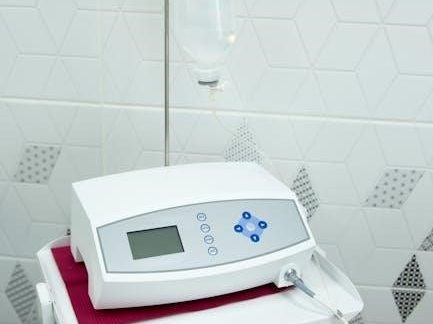Immediate Post-Operative Care
After dental implant surgery, control bleeding by biting on gauze for 30-60 minutes. Avoid rinsing, smoking, or vigorous activities for 24-48 hours. Apply ice packs to reduce swelling and elevate your head to minimize discomfort. Rest and avoid disturbing the surgical site to promote healing. Stick to a soft diet and avoid hot liquids or foods during the initial recovery period.
1.1 Managing Bleeding
Managing bleeding after dental implant surgery involves biting on gauze with firm pressure for 30-60 minutes to encourage clotting. Minor oozing is normal, but if bleeding persists or increases, contact your dentist immediately. Avoid spitting, rinsing, or disturbing the surgical site to ensure proper healing and prevent complications.
1.2 Controlling Swelling
To control swelling, apply an ice pack to the surgical area for 20 minutes on and 10 minutes off during the first 48 hours. Keep your head elevated using 2-3 pillows while resting. This helps reduce facial swelling and promotes healing. Avoid strenuous activities and follow your dentist’s instructions for optimal recovery.
1.3 Rest and Relaxation
Rest is crucial after dental implant surgery to aid healing. Avoid strenuous activities, bending, or heavy lifting for the first 3-4 days. Limit physical exertion and prioritize relaxation. Ensure adequate sleep to support recovery. Resume normal activities gradually, as tolerated, while following your dentist’s guidance for a smooth healing process.

Pain Management
Manage discomfort with prescribed medications or over-the-counter pain relief as directed. Rest and avoid activities that worsen pain. Follow your dentist’s advice to ensure proper healing and comfort.
2.1 Prescription Medications
Prescription medications, such as pain relievers and antibiotics, are crucial for managing post-operative discomfort and preventing infection. Start taking prescribed meds as directed, even before the anesthetic wears off, to stay ahead of pain. Antibiotics may be prescribed to reduce infection risks, so adhere to the full course. Take medications with soft foods to avoid stomach upset.
2.2 Over-the-Counter Pain Relief
Over-the-counter pain relievers like ibuprofen or naproxen can effectively manage mild to moderate post-operative discomfort. These medications reduce inflammation and pain without a prescription. Always follow the recommended dosage on the label or as advised by your dentist. Avoid exceeding the maximum daily dose to prevent potential side effects or complications.
2.3 Managing Discomfort
Apply ice packs to reduce swelling and alleviate discomfort. Stick to a soft diet, avoiding hard or sharp foods that may irritate the surgical site. Rest and avoid strenuous activities during the initial recovery phase. Gently massage sore muscles if needed, and elevate your head to minimize swelling and promote healing.

Diet and Nutrition
Stick to a soft, nutritionally balanced diet with foods like yogurt, smoothies, and soups. Avoid hard, sharp, or hot items that could irritate the surgical site. Proper nutrition supports healing and recovery.
3.1 Recommended Foods
Opt for soft, nutrient-rich foods like yogurt, smoothies, Jell-o, pudding, and soups. Gentle options such as scrambled eggs, mashed potatoes, and applesauce are ideal. These foods are easy to chew, reducing discomfort and supporting the healing process without irritating the surgical site.
3.2 Foods to Avoid
Avoid hot liquids, hard foods, and crunchy or sticky items. Do not consume spicy or sharp foods that could irritate the surgical site. Refrain from using straws to prevent dislodging the blood clot. Avoid foods that require heavy chewing to minimize discomfort and protect the healing implant area.
3.4 Staying Hydrated
Drink plenty of water to stay hydrated and aid healing. Opt for cool or room-temperature fluids to avoid discomfort. Avoid using straws, as they can dislodge the blood clot. Broths and lukewarm soups are good options to maintain hydration without irritating the surgical site during recovery.
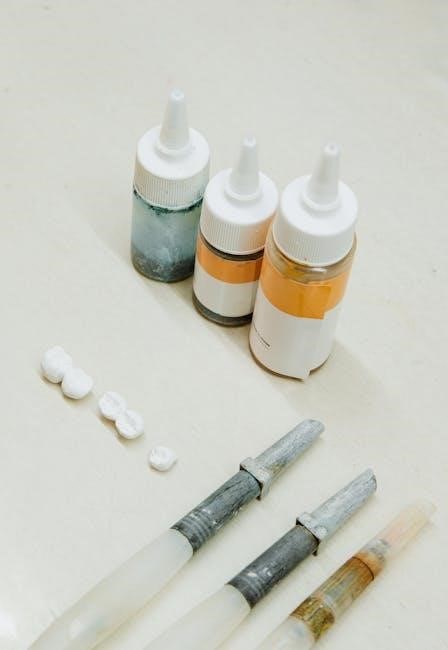
Oral Hygiene
Maintain oral hygiene by rinsing with saline solution and gently brushing around the surgical site. Avoid harsh mouthwashes and focus on keeping the area clean to promote healing.
4.1 Rinsing and Cleaning
After surgery, rinse with saline solution 24 hours. Gently swish lukewarm saltwater around the mouth without vigorous rinsing. Avoid disturbing the surgical site with your tongue or fingers. Use a soft-bristle toothbrush to clean surrounding teeth, keeping the implant area undisturbed. This promotes healing and prevents complications.
4.2 Brushing Techniques
Use a soft-bristle toothbrush to gently clean teeth and surrounding areas. Begin brushing 24-48 hours post-surgery, avoiding direct contact with the implant site. Use gentle strokes and mild toothpaste to maintain oral hygiene without irritating the surgical area or disrupting the healing process. Avoid harsh or abrasive products that may damage tissues.
4.3 Avoiding Contamination
To prevent contamination, keep the surgical site clean with saline rinses. Avoid smoking, using straws, and touching the area with fingers or tongue to reduce bacterial transfer. Maintain proper oral hygiene practices to minimize infection risks and ensure proper healing.
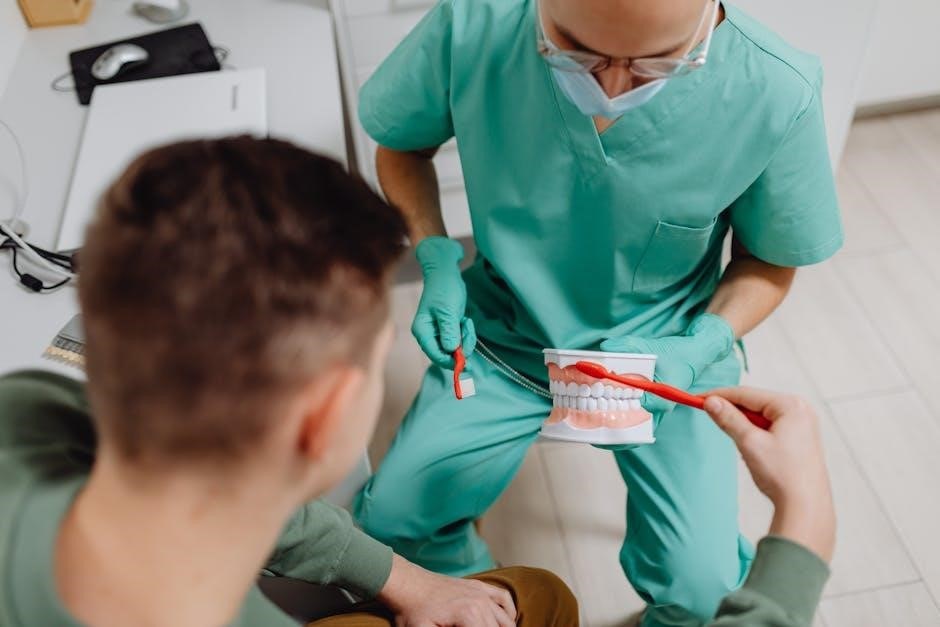
Activity Levels
Avoid physical strain for the first 3-4 days post-surgery. Rest and limit vigorous activities to promote healing. Gradually resume daily activities as comfort allows, avoiding heavy exercise.
5.1 Avoiding Physical Strain
Limit physical activity for 3-4 days post-surgery to avoid discomfort or complications. Avoid bending, lifting heavy objects, or strenuous exercises. Excessive strain can dislodge the implant or delay healing. Resting ensures proper recovery and reduces risks of post-operative issues.
5.2 Resuming Daily Activities
Resume normal activities gradually after 4 days, avoiding strenuous tasks. Light exercises and routine chores are typically manageable. Be patient and avoid overexertion, as healing continues. Listen to your body and rest if discomfort arises. Consult your dentist for personalized advice on safely returning to daily routines without risking complications.

Monitoring for Complications
Monitor for unusual bleeding, severe pain, swelling, or numbness. Contact your dentist immediately if symptoms persist or worsen to address potential complications early.
6.1 Signs of Infection
Monitor for redness, swelling, or pus around the implant site. Increased pain, fever, or a bad taste in the mouth may indicate infection. Contact your dentist immediately if these symptoms persist or worsen to ensure proper treatment and prevent complications.
6.2 Numbness or Tingling
Numbness or tingling near the implant site may occur due to nerve irritation during surgery. This is usually temporary and improves as healing progresses. If numbness persists or worsens, contact your dentist promptly. Rest, ice packs, and adhering to prescribed medications can help manage discomfort during recovery.
6.3 Implant Mobility
Implant mobility may occur if the implant shifts during healing. Minor movement is normal but should decrease as osseointegration progresses. Avoid touching the implant site, as this can dislodge it. If mobility persists or increases, contact your dentist immediately to prevent complications and ensure proper integration with the surrounding bone.
Follow-Up Care
Attend all scheduled appointments to monitor healing and ensure proper implant integration. Sutures are typically removed 7-10 days post-surgery. Follow-up care ensures long-term success and addresses any concerns promptly.
7.1 Scheduled Appointments
Regular follow-ups with your dentist are crucial for monitoring healing progress. Typically, appointments are scheduled at 1-2 weeks, 1-3 months, and 6 months post-surgery to ensure proper osseointegration and address any concerns. These visits allow your dentist to assess implant stability and prepare for the next steps in your treatment plan.
7.2 Removing Stitches
Stitches are typically removed 7-10 days after surgery, depending on healing progress. Dissolvable sutures may not require removal. Attend your scheduled appointment for suture removal to ensure proper healing. Avoid disturbing the stitches and follow your dentist’s care instructions to prevent complications and promote a smooth recovery process.
7.3 Long-Term Maintenance
Regular dental checkups and cleanings are crucial for long-term implant success. Maintain good oral hygiene, including gentle brushing and flossing around the implant. Avoid smoking and chewing on hard objects to prevent damage. Schedule annual x-rays to monitor osseointegration and ensure proper function and stability of the implant over time.
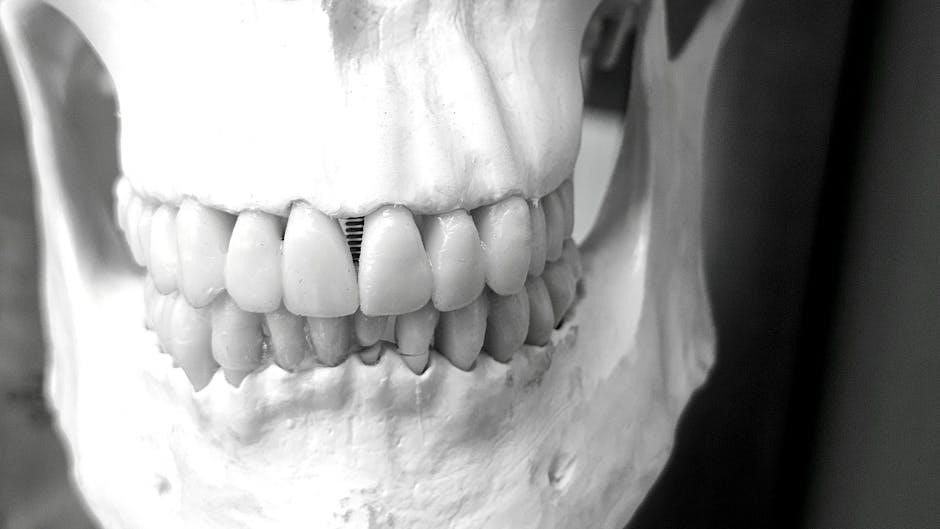
Additional Tips
- Avoid smoking to promote healing and prevent complications.
- Use ice packs to reduce swelling and discomfort.
- Elevate your head while resting to minimize swelling.
8.1 Avoiding Smoking
Avoid smoking to ensure proper healing and prevent complications. Smoking reduces blood flow, delaying recovery and increasing the risk of infection or implant failure. Refrain from smoking for at least 48 hours post-surgery. Consider nicotine replacement therapy or consult your doctor for support. This promotes a healthier recovery and better implant success.
8.2 Using Ice Packs
Apply ice packs to the surgical area for 20 minutes on and 10 minutes off during the first 48 hours. This helps reduce swelling and discomfort. Wrap the ice in a cloth to avoid skin irritation. Consistent use minimizes facial swelling, promoting a smoother recovery and faster healing process.
8.3 Elevating the Head
Elevating the head during recovery helps minimize facial swelling and promotes healing. Use an extra pillow to keep your head slightly upright while resting. This simple step can significantly improve comfort and reduce post-operative swelling, aiding in a smoother healing process.

Medications
Medications are crucial for a smooth recovery. Antibiotics prevent infection, while pain relievers and anti-inflammatory drugs manage discomfort and swelling. Follow your dentist’s instructions precisely.
9.1 Antibiotics
Antibiotics are prescribed to prevent infection after dental implant surgery. Start taking them immediately as directed, typically beginning within hours of the procedure. Complete the full course to ensure effectiveness, even if symptoms improve. Notify your dentist if you experience side effects or allergic reactions.
9.2 Anti-Inflammatory Drugs
Anti-inflammatory drugs, such as ibuprofen or naproxen, are often prescribed to reduce swelling and pain post-surgery. Use as directed for 2-3 days to minimize discomfort. These medications help alleviate inflammation without interfering with the healing process when taken as recommended.
9.3 Adherence to Prescriptions
Adhering to prescribed medications is crucial for recovery. Start antibiotics and painkillers as directed, typically after eating to avoid nausea. Follow dosage instructions carefully and avoid exceeding recommended limits. Proper use ensures infection prevention and pain management, promoting a smooth healing process. Contact your dentist if questions arise.

Preventing Infection
Prevent infection by following strict oral hygiene practices, using saline rinses, and avoiding irritants. Monitor for signs of infection and maintain cleanliness to ensure proper healing. Antibiotics may be prescribed to reduce infection risks, so adhere to the medication regimen as directed by your dentist.
10.1 Saline Rinses
Rinse with a saline solution (½ teaspoon of salt in 8 ounces of warm water) starting the day after surgery. Gently swish the solution around your mouth, especially near the implant site, to reduce bacteria and promote healing. Repeat 2-3 times daily to prevent infection and support recovery.
- Use warm water for comfort.
- Avoid vigorous rinsing to prevent dislodging the blood clot.
10.2 Avoiding Irritants
Avoid smoking, alcohol, and spicy or sharp foods that can irritate the surgical site. Refrain from using harsh mouthwashes or abrasive toothpaste. Do not touch or disturb the implant area with fingers or utensils, as this can introduce bacteria and delay healing. Keep the area clean and free from contaminants.
- Smoking and alcohol can slow healing and increase infection risk.
- Sharp foods may dislodge the blood clot or damage the implant.
10.3 Maintaining Cleanliness
Gently rinse with saline solution or antibacterial mouthwash as directed. Avoid harsh products and use a soft-bristle toothbrush around the implant site. Keep the area clean to prevent infection and promote healing. Regular cleansing helps maintain a healthy environment for proper recovery and integration of the implant.
- Rinse with saline solution 2-3 times daily.
- Avoid using abrasive toothpaste or rough cloths.
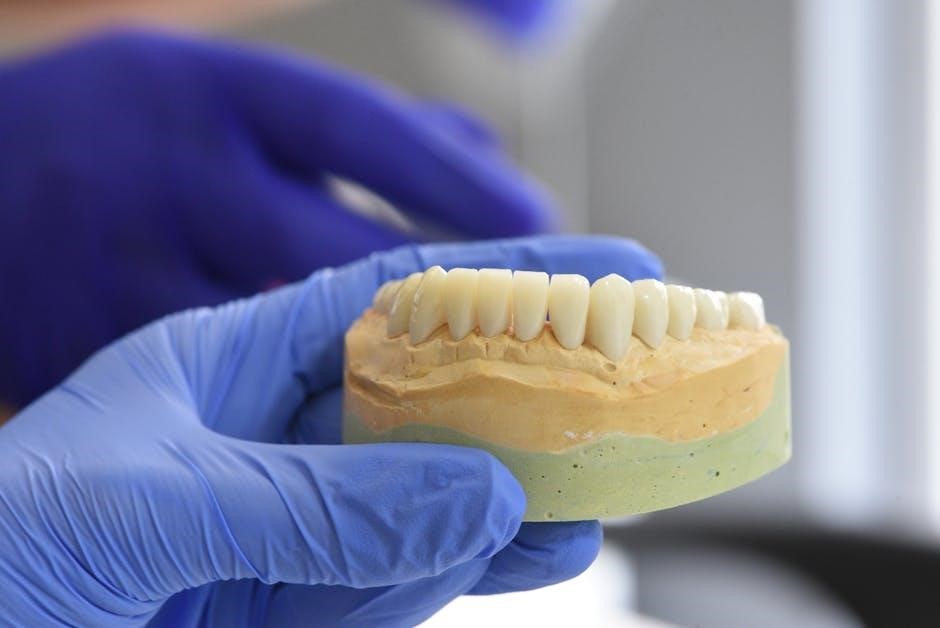
Long-Term Recovery
Long-term recovery involves osseointegration over 3-6 months. The implant integrates with bone, ensuring stability. After healing, the final restoration is placed, completing the process.
11.1 Healing Process Timeline
The healing process for dental implants typically spans 3-6 months. Immediate stability is achieved post-surgery, with osseointegration progressing gradually. Soft tissue healing occurs within 1-2 weeks, while full bone integration takes several months. After this period, the implant is ready for the final restoration, ensuring long-term functionality and aesthetics.
11.2 Osseointegration
Osseointegration is the critical process where the dental implant fuses with the jawbone, creating a stable base for the prosthetic tooth. This biological bonding typically occurs over 3-6 months post-surgery, ensuring the implant becomes a permanent, functional part of your mouth, essential for long-term success and durability of the dental implant.
11.4 Final Restoration
After successful osseointegration, the final restoration involves attaching the abutment and crown to the implant. This step ensures the implant blends naturally with your smile, both in appearance and function. Your dentist will ensure a precise fit and proper aesthetics, completing your dental implant journey for a durable, long-lasting result.
Adhering to post-operative instructions ensures a smooth recovery and successful dental implant outcome. Proper care and patience will lead to a natural, functional smile, improving overall oral health and confidence.
12.1 Importance of Compliance
Strictly following post-operative instructions is crucial for proper healing, minimizing complications, and ensuring implant success. Compliance reduces risks like infection or implant failure, promoting a smooth recovery and optimal results. Non-compliance may lead to prolonged healing or additional procedures, emphasizing the need for adherence to your dentist’s guidance.
12.2 Ensuring Success
Adhering to post-operative instructions ensures proper healing and implant integration. Maintaining oral hygiene, avoiding smoking, and following dietary guidelines are essential. Compliance with medication schedules and attending follow-up appointments further supports success. Regular check-ups and professional care help monitor healing and address concerns promptly, ensuring long-term functionality and aesthetic outcomes of your dental implant.
12.3 Final Tips
Stay informed, attend follow-ups, and maintain open communication with your dentist. Be patient and persistent, as proper care ensures long-term success. Keep the surgical site clean, avoid irritants, and stay hydrated to promote healing. By following these tips, you’ll achieve optimal results and enjoy the benefits of your dental implant for years to come.
